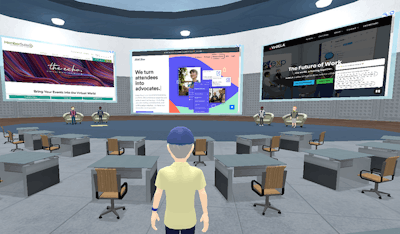
We get it: It's difficult to find a virtual event platform that has it all. And while the industry is thankful for the many options, picking the perfect platform can be overwhelming, and even feel a little like speed dating your way to the right virtual venue for your event—except there's no app for that. Luckily, that's why you have us (wink). Here, BizBash tapped a few event professionals to see what features are must-haves when selecting a virtual event platform.
1. Features that achieve the goal of your event
Even though the path to the perfect platform isn't easy, start with the basics. Why are you producing this event? Then the search can begin, because it's not a one-size-fits-all process. "Know at least the skeleton of your strategy for the event so you can vet platform options against it," advises Lisa Marks, founder of Brand Alive. For example, if you're producing a virtual fundraiser, narrow down your platform options to those with easy donation features, such as a fundraising thermometer. On the other hand, a product launch may be better suited for a platform that offers VR demonstrations.
2. As few barriers of entry as possible
For virtual events, registration isn't as simple as showing up and reporting to the nearest iPad, and if your attendee loses their registration link, you may just lose their presence overall. Take note of platforms that include registration and ticketing options as part of their features, rather than a platform the requires attendees to check in through a separate browser link. Maria Underwood, vice president of development at YWCA of Central Alabama, prefers software that doesn't require a username and password, hoping to remove as many barriers to attending as possible.
3. Networking functions
Prioritize virtual event platforms that allow attendees to network with each other. Not only does this allow attendees opportunities to stay actively engaged during the event, but it allows them an opportunity to create connections that will last after the event has ended. Plus, networking sessions are a good way to break up long keynotes or workshops.
4. An on-demand support team for the organizer and a live chat support feature for the attendee
Technology can be unpredictable (bad Internet connection, power outage, loss of Wi-Fi signal) and even the smallest of hiccups can severely affect the attendee experience and engagement levels. When weighing your platform options, consider the value of having an on-call support team for the event organizer to tap if tech problems arise, as well as a live chat support feature for the attendee to utilize if faced with an issue. This way, you as the organizer can focus on making your event shine and let tech support handle the rest.
5. Personalized branding and customization options
"Our client didn't want a cookie-cutter template look, and they were willing to get outside of their comfort zone to get it," says Bryan Pray, executive producer at FoxDog Consultants. Pray also notes the importance of the ability to "white label" the platform. (Translation: Don't let the platform's branding distract from your own.) Instead, utilize platforms that morph into the virtual venue you need them to be. Marks adds, "I like to enable guests to customize their profile or avatar, allowing the participant to select from a handful of images that the company has pre-created, perhaps in line with company values."
6. Real-time and post-event data analytics
A big benefit to virtual events is the ability for event planners to get real-time analytics that can better the experience of their next online gathering. You'll want to choose a platform that can provide this data for you, both during and after the event.
7. Individual attendee engagement opportunities
To avoid "Zoom fatigue," you'll want to select a platform that allows your attendees to engage not only with each other but also with more interactive parts of the event, such as panels and fireside chats. (This helps replicate the inclusivity of live events.) For example, the extroverted participant may benefit from a hand-raising feature, whereas a live polling function could be more popular among the quieter attendee. Either way, both types of eventgoer feel included and engaged with the event and its content.
8. A price tag within your budget
While some virtual event platforms offer basic services for free, others that are more intricate and customizable can come with a price tag of $500, $5,000, or even higher. It's important to first establish your budget, as well as your must-have features, before diving into the search for a virtual event platform. This will help you narrow your search by how much it will cost. For those with a more flexible budget, fully customizable virtual event platforms may be the best plan of action, so you can build exactly what you want, how you want it. On the other hand, if you're looking to save on costs, take note of platforms that offer packages versus an a la carte menu of features, as those can add up quickly. For example, owner of Emenee Marketing 'n' Events Michelle McNabb says, "When it comes to price, my clients just want to see clear options in a package—not add-ons to a base rate that adds up all-inclusive."
9. A user-friendly yet aesthetically pleasing design
Selecting a virtual event platform that offers user-friendly design is vital for your attendees' experience. If the design is unclear or too complicated, you may face attendee drop-off in greater numbers than you expected. Did your previous live events aim to be "Instagram-worthy"? Then make it a goal to ensure your virtual event can still be "screenshot-worthy" by choosing a platform that allows for a more aesthetically pleasing layout.
For online business meetings, though, a simpler, less distracting design may be best. For instance, Marks explains that she looks for a platform "that is easy to understand and navigate from the attendee experience side and offers privacy in terms of the client-side."




![Hd Gameplay Ff[1][1]](https://img.bizbash.com/files/base/bizbash/bzb/image/2021/04/HD_GAMEPLAY_FF_1__1_.607dd143b9766.png?auto=format%2Ccompress&fit=crop&h=167&q=70&w=250)














